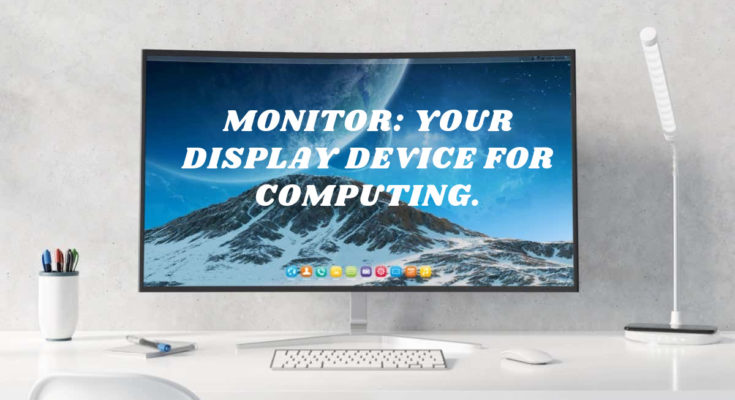MONITOR :-
A monitor, also known as a computer display or screen, is an electronic device that displays visual output from a computer, video camera, or other source. It typically consists of a display screen, a casing, and electronics that receive a video signal from the computer’s video output and display the image on the screen.
There are many different types of monitors, including CRT (cathode ray tube), LCD (liquid crystal display), LED (light-emitting diode), and OLED (organic light-emitting diode). They come in various sizes and resolutions, from small displays used in laptops and tablets to large screens used for gaming or professional work.
Monitors can be connected to a computer via a variety of interfaces, including VGA, DVI, HDMI, and DisplayPort. They can also have additional features such as built-in speakers, USB ports, and touchscreens.
In addition to being used with computers, monitors can also be used for other purposes such as displaying CCTV camera feeds, as a television screen, or in video production and editing.
MONITOR: YOUR DISPLAY DEVICE FOR COMPUTING
A monitor is a display device that is used to visually present information from a computer or other electronic device. It is the primary output device for computers and allows users to view the processed data, images, videos, and other visual content generated by the computer’s graphics card.
Monitors come in various sizes, resolutions, and technologies, offering different features and capabilities. Here are some key aspects of a monitor:
1. Display Technology: Monitors can use different display technologies, including LCD (Liquid Crystal Display), LED (Light Emitting Diode), OLED (Organic Light Emitting Diode), and more. Each technology has its advantages and disadvantages in terms of image quality, energy efficiency, response time, and viewing angles.
2. Resolution: The resolution of a monitor refers to the number of pixels it can display horizontally and vertically. Common resolutions include Full HD (1920×1080 pixels), Quad HD (2560×1440 pixels), and 4K Ultra HD (3840×2160 pixels). Higher resolutions generally result in sharper and more detailed images.
3. Refresh Rate: The refresh rate indicates how many times per second the monitor updates the displayed image. It is measured in Hertz (Hz). Higher refresh rates, such as 144Hz or 240Hz, can provide smoother motion and reduce motion blur, which is beneficial for gaming or fast-paced content.
4. Response Time: Response time refers to the time it takes for a pixel to change from one color to another. Lower response times are desirable, especially for gaming and other activities that involve rapid image transitions, as they minimize ghosting and motion artifacts.
5. Panel Type: LCD monitors typically use different panel types, such as Twisted Nematic (TN), In-Plane Switching (IPS), Vertical Alignment (VA), and others. Each panel type has its characteristics regarding color accuracy, contrast ratio, and viewing angles.
6. Connectivity: Monitors offer various connectivity options to connect them to the computer, such as HDMI, DisplayPort, DVI, VGA, and USB. The choice of connectivity depends on the available ports on your computer’s graphics card and the desired capabilities.
7. Size and Aspect Ratio: Monitors come in different sizes, ranging from compact displays under 20 inches to large screens exceeding 30 inches. The aspect ratio determines the width-to-height ratio of the display, with common ratios being 16:9 (widescreen) or 21:9 (ultrawide).
8. Ergonomics: Some monitors offer adjustable stands that allow you to change the height, tilt, and swivel of the display. Ergonomic features are important for ensuring comfortable viewing angles and reducing strain on the neck and eyes during prolonged computer use.
These are just a few key aspects to consider when choosing a monitor. Depending on your specific needs, you may prioritize certain features over others, such as color accuracy for graphic design work, high refresh rates for gaming, or a large screen for multimedia consumption.
TYPES:-
There are several types of monitors available in the market, each with its unique features and specifications. Here are some of the most common types of monitors:
1. CRT (Cathode Ray Tube) monitors: CRT monitors are bulky and outdated, but they were once the most popular type of monitor. They use electron beams to create an image on the screen and have a curved screen that can cause some distortion. They have now largely been replaced by newer technologies.
2. LCD (Liquid Crystal Display) monitors: LCD monitors are thinner and more energy-efficient than CRT monitors. They use a liquid crystal display to create images on the screen, and they are available in a range of sizes and resolutions.
3. LED (Light Emitting Diode) monitors: LED monitors are a type of LCD monitor that uses LED backlighting to illuminate the screen. They are thinner and more energy-efficient than standard LCD monitors and offer better color accuracy.
4. OLED (Organic Light Emitting Diode) monitors: OLED monitors are the latest technology in monitors. They use organic compounds that emit light when an electric current is passed through them to create images on the screen. They offer high contrast, deep blacks, and bright colors.
5. Touchscreen monitors: Touchscreen monitors have a built-in touch-sensitive panel that allows you to interact with the screen directly, without the need for a mouse or keyboard. They are commonly used in kiosks, point-of-sale systems, and in some laptops and tablets.
6. Gaming monitors: Gaming monitors have a fast refresh rate and low input lag, making them ideal for gamers who want a smooth and responsive gaming experience. They often have a higher resolution and a larger screen size than standard monitors.
7. Ultrawide monitors: Ultrawide monitors have an aspect ratio of 21:9, which provides a wider field of view than standard monitors. They are popular with gamers and content creators who want more screen space for multitasking.
These are just a few of the most common types of monitors available, and there are many other variations and types available depending on your needs and preferences.
FUNCTIONS :-
The primary function of a monitor is to display visual output from a computer or other source. However, modern monitors can perform a variety of additional functions and features, including:
1. Displaying multiple sources: Some monitors allow you to display multiple sources on the screen simultaneously, which is useful for multitasking or comparing different data.
2. Adjusting settings: Monitors have settings that you can adjust to customize the display to your preferences, including brightness, contrast, color temperature, and gamma.
3. Built-in speakers: Some monitors have built-in speakers that allow you to hear audio without the need for external speakers.
4. Touchscreen functionality: Touchscreen monitors allow you to interact with the screen directly, which is useful for certain applications and workflows.
5. Screen rotation: Some monitors can rotate to allow for vertical viewing, which is useful for working with documents or websites that are designed for vertical viewing.
6. Picture-in-picture: Some monitors have a picture-in-picture function that allows you to display two sources at the same time, with one source taking up the majority of the screen and the other displayed in a smaller window.
7. Gaming-specific features: Gaming monitors may have features such as a high refresh rate, low input lag, and adaptive sync technology to provide a smoother and more responsive gaming experience.
8. Ergonomic features: Some monitors have adjustable stands that allow you to adjust the height, tilt, and angle of the screen to reduce eye strain and improve ergonomics.
These are just a few of the many functions and features that monitors can offer. The specific features and functions that a monitor provides will depend on the model and manufacturer.



